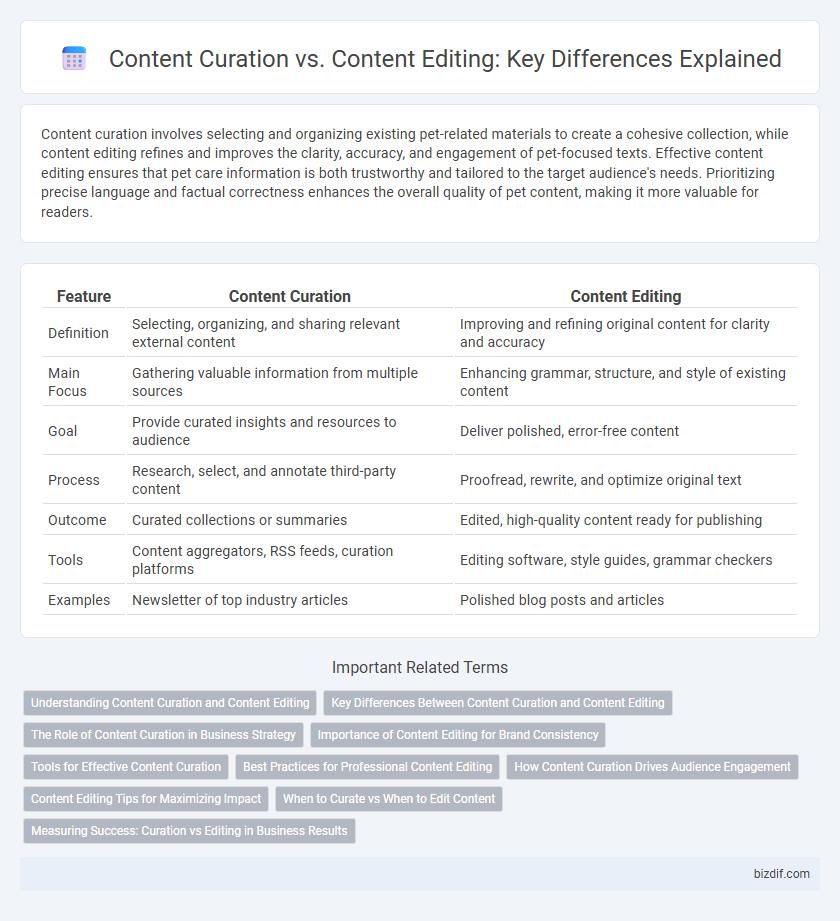Content curation involves selecting and organizing existing pet-related materials to create a cohesive collection, while content editing refines and improves the clarity, accuracy, and engagement of pet-focused texts. Effective content editing ensures that pet care information is both trustworthy and tailored to the target audience's needs. Prioritizing precise language and factual correctness enhances the overall quality of pet content, making it more valuable for readers.
Table of Comparison
| Feature | Content Curation | Content Editing |
|---|---|---|
| Definition | Selecting, organizing, and sharing relevant external content | Improving and refining original content for clarity and accuracy |
| Main Focus | Gathering valuable information from multiple sources | Enhancing grammar, structure, and style of existing content |
| Goal | Provide curated insights and resources to audience | Deliver polished, error-free content |
| Process | Research, select, and annotate third-party content | Proofread, rewrite, and optimize original text |
| Outcome | Curated collections or summaries | Edited, high-quality content ready for publishing |
| Tools | Content aggregators, RSS feeds, curation platforms | Editing software, style guides, grammar checkers |
| Examples | Newsletter of top industry articles | Polished blog posts and articles |
Understanding Content Curation and Content Editing
Content curation involves selecting, organizing, and presenting relevant information from various sources to create value for a specific audience, ensuring that the content aligns with targeted themes and user interests. Content editing focuses on refining the clarity, accuracy, tone, and structure of original content to enhance readability and engagement while maintaining the author's voice and intent. Understanding the distinction between content curation and content editing is essential for effective content strategy development and precise audience targeting.
Key Differences Between Content Curation and Content Editing
Content curation involves gathering, organizing, and presenting existing information from various sources, while content editing focuses on refining and improving original material for clarity, accuracy, and engagement. Key differences include the source of content--curation relies on external content, whereas editing works with internally created content--and the objectives, with curation aiming to provide valuable resources and editing targeting enhanced readability and coherence. Effective content strategy often integrates both, leveraging curated insights alongside polished original content for maximum impact.
The Role of Content Curation in Business Strategy
Content curation involves selecting, organizing, and sharing relevant information to engage target audiences and position a brand as an industry authority. In business strategy, it enhances thought leadership, supports marketing campaigns, and drives audience trust by consistently providing valuable insights. Effective content curation complements content editing by ensuring the curated material aligns with brand voice and quality standards.
Importance of Content Editing for Brand Consistency
Content editing plays a critical role in maintaining brand consistency by ensuring that all materials align with the company's voice, style, and messaging guidelines. Unlike content curation, which involves selecting and organizing external content, content editing refines and adapts content to meet specific brand standards and audience expectations. This process strengthens brand identity, builds trust with the target audience, and enhances overall communication effectiveness.
Tools for Effective Content Curation
Content curation tools such as Scoop.it, Curata, and Feedly enable efficient aggregation and organization of relevant articles, enhancing content discovery and audience engagement. These platforms utilize filters, AI algorithms, and customizable dashboards to streamline the selection of high-quality information from diverse sources. Integrating these tools with content management systems accelerates workflow and ensures curated content aligns with editorial standards.
Best Practices for Professional Content Editing
Professional content editing involves refining structure, clarity, and style to align with brand voice and audience expectations, while content curation primarily aggregates relevant topics without modification. Best practices for content editing prioritize fact-checking, eliminating redundancy, and enhancing readability through precise language and consistent tone. Implementing thorough revisions and utilizing style guides ensures accuracy and maximizes engagement in professional content outputs.
How Content Curation Drives Audience Engagement
Content curation drives audience engagement by selectively gathering and organizing relevant, high-quality information that resonates with the target audience, enhancing their experience and trust. Curated content provides a diverse array of perspectives and insights, encouraging interaction and sharing across platforms. Unlike content editing, which refines individual pieces, curation strategically builds a cohesive narrative that keeps audiences consistently engaged and informed.
Content Editing Tips for Maximizing Impact
Content editing enhances clarity, coherence, and tone to align with the target audience and communication goals. Prioritize thorough proofreading, consistent style adherence, and restructuring sentences for better flow to maximize impact. Incorporate feedback loops and fact-checking to ensure accuracy and maintain credibility across all content forms.
When to Curate vs When to Edit Content
Content curation is ideal for aggregating relevant information from various sources to provide a broad perspective or ongoing updates, while content editing suits refining and improving original material to enhance clarity, accuracy, and engagement. Curate content when the goal is to showcase diverse viewpoints or compile comprehensive resources without significant alteration. Edit content when precision, consistency, and tone need adjustment to align with specific brand guidelines or audience preferences.
Measuring Success: Curation vs Editing in Business Results
Measuring success in content curation involves tracking metrics like audience engagement, shares, and traffic growth, reflecting the value of aggregated and relevant content to the target market. Content editing success is assessed through improved clarity, coherence, and conversion rates, directly impacting user experience and sales performance. Businesses prioritizing curation often see broader reach and brand authority, while editing sharpens messaging to boost lead generation and customer retention.
Content Curation vs Content Editing Infographic

 bizdif.com
bizdif.com